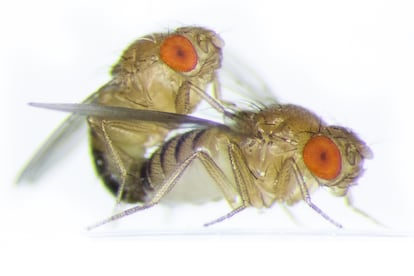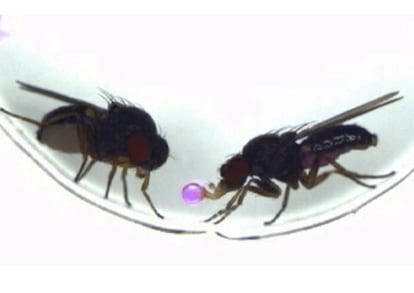A genetic modification transfers to a fly the habit of another species of regurgitating before copulating


A common species of fruit fly, Drosophila subobscura , has a peculiar mating ritual. To accept copulation, the female requires the male to regurgitate food directly into her mouth. This is a characteristic innate behavior, not observed in other fruit fly species, such as Drosophila melanogaster , whose males simply compose courtship sounds by vibrating their wings. Some 30 million years of evolution separate the two species. A team of Japanese scientists has now managed to transfer the ritual from one species to another with a simple genetic modification. In a laboratory at Nagoya University, male Drosophila melanogaster have begun regurgitating food into the mouths of females before copulating. The authors claim that this is the first time that a behavior has been transferred between species by manipulating a single gene.
The experiment reveals an astonishing phenomenon. Both species share a stretch of DNA, the fru gene, which controls male courtship behavior. However, some play music, while others offer regurgitated nuptial gifts. The scientists, led by geneticist Daisuke Yamamoto , observed that by hyperactivating the gene in a group of Drosophila melanogaster neurons, these cells develop long projections that create new brain circuits and generate the behavior of regurgitation into the female's mouth. Their results show that a small reconfiguration of neurons is enough to rescue ancestral behavior. The study is published this Thursday in the journal Science , a benchmark for the world's best science.
In March 2023, Spanish biologist Albert Cardona and his Croatian colleague Marta Zlatic presented the first complete map of an animal brain: that of the larva of the fly Drosophila melanogaster . A year later, an international consortium obtained the map of the adult brain : 140,000 neurons, with some 55 million connections between them. Cardona believes that the new study "is very interesting, but, although it may seem new, it is not very new." The biologist recalls that two years ago, neuroscientist Tomoko Ohyama demonstrated that by manipulating the activity of a neuron in Drosophila melanogaster larvae, she could reproduce the characteristic escape behavior of another species of fly, Drosophila santomea , whose larvae escape by rolling away from harmful stimuli.
Cardona, from Cambridge's Molecular Biology Laboratory, explains that he and another Spanish biologist working in the United Kingdom, Lucía Prieto Godino , published preliminary results of a similar study in June. The authors mapped the neural circuitry of the olfactory system of the fly Drosophila erecta , an insect endemic to West Africa that feeds exclusively on the fruits of a tropical shrub. After analyzing the mechanism of this preference, the team genetically manipulated the neural connections of the fly Drosophila melanogaster so that it also preferred the African fruit.

The biologist regrets that the Japanese study does not cite these two precedents, but recognizes the value of the new results. "What should be highlighted is that, although separated by 30 million years, the two species of fly, Drosophila melanogaster and Drosophila subobscura , are capable of the same behavior—sharing a nuptial gift [regurgitated food]—but in the former it does not occur naturally, while in the latter it does. This leads to speculation that evolution does not necessarily have to form new circuits , but merely fine-tune the intensity of the connections between neurons, and this is enough to change behavior, as first described by Tomoko Ohyama and Lucía Prieto Godino," the researcher reflects.
Prieto Godino directs a laboratory at the Francis Crick Institute in London that investigates the evolution of neural circuits : the connections between cells on which thoughts, memories, and behavior depend. The biologist applauds the study that has transferred the regurgitation ritual. “This work shows that potentially simple genetic changes—such as changing the expression of a gene in neurons that don't normally express it—can change how those neurons connect with the rest of the circuits, and how that, in turn, can change behavior,” she emphasizes.
Geneticist Daisuke Yamamoto explains why he believes his transfer of the habit of regurgitating before copulation goes beyond previous studies. “We have managed to transfer an entire behavioral pattern from one species to another by manipulating a single master gene that controls a specific behavior,” argues Yamamoto, of the National Institute of Information and Communications Technology in Kobe, in an email message. “As far as I know, this is the first time this has been done. Previous work has induced changes in the intensity of a response or in preferences or aversions, but not in the behavioral repertoires themselves,” he adds.
EL PAÍS




